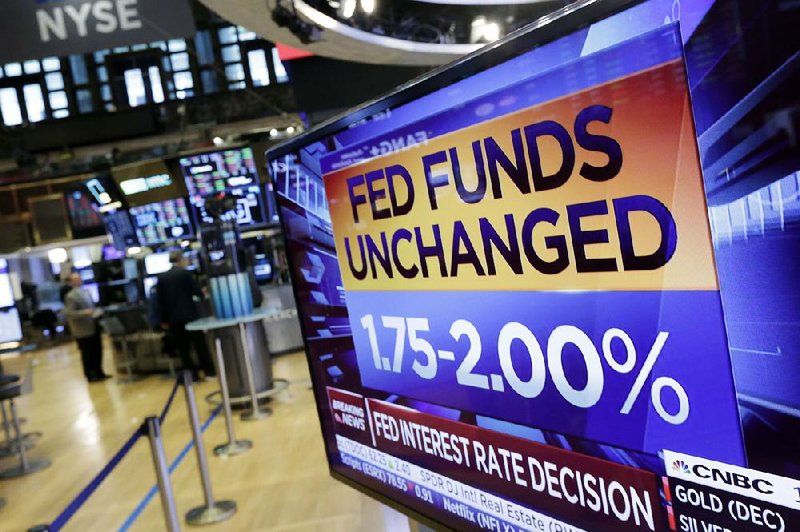WASHINGTON -- The Federal Reserve left its benchmark interest rate unchanged on Wednesday, keeping the rate in a range of 1.75 percent to 2 percent, but the central bank said the U.S. economy is "strong" and hinted that more rate increases are coming soon.
President Donald Trump has urged the Fed to keep rates low, but the central bank is an independent body, and Fed leaders have made clear that they intend to carry out their mandate to keep unemployment down and prices stable without political interference. Fed policymakers think the U.S. economy is on very good footing now and that the historically low rates that were put in place to aid the economy in the aftermath of the recession are no longer necessary.
The Federal Open Market Committee's decision was approved on an 8-0 vote.
"The labor market has continued to strengthen and ... economic activity has been rising at a strong rate," the Fed said in its statement Wednesday, adding that it expects "further gradual increases" in interest rates.
The Fed has predicted it will raise interest rates two more times this year and three times in 2019. The vast majority of economists and Wall Street traders think the Fed will lift rates to a range of 2 percent to 2.25 percent at its next meeting in late September and then to a range of 2.25 percent to 2.5 percent at its meeting in December, according to the CME FedWatch Tool, which traders use to make predictions about future Fed actions. These rates are still low by historical standards, but they would be the highest rates in a decade.
Rate increases in March and June followed three increases in 2017 and one each in 2015 and 2016. The Fed's key policy rate is still at a relatively low level. But it's up from the record low near zero where it remained for seven years as the central bank worked to use ultralow interest rates to lift the economy out of the recession.
Fed Chairman Jerome Powell said recently that the U.S. economy is "in a really good place." While Fed leaders have warned that tariffs imposed by Trump and other countries in recent weeks could slow growth, they have said the economy continues to power ahead despite those concerns. The Fed statement on Wednesday described economic conditions as strong or strengthening five times.
Powell is trying to nurture the second-longest U.S. expansion on record by slowly reducing the amount of support that monetary policy provides to growth. The economy is riding a tail wind from tax cuts and higher federal spending, though a trade war threatens to dent growth.
Unemployment is at 4 percent, one of the lowest levels in years, and growth hit 4.1 percent in the second quarter, the best quarterly bounce since 2014. Inflation remains modest, with most metrics just shy of the Fed's 2 percent target, and the stock market has stayed near record highs.
The Fed is trying to lift interest rates gradually to a more normal level, which central bank leaders put at about 3 percent, but Trump has long preferred low rates since it makes it cheaper to borrow money to build new real estate or expand a business.
"I don't like all of this work that we're putting into the economy and then I see rates going up," Trump told CNBC in July, adding that he was "not thrilled" with Powell's plan to gradually raise rates. Modern presidents have typically shied away from commenting on Fed policy, although George W. Bush later blamed the central bank for his re-election loss, arguing the Fed raised rates too quickly and triggered a slowdown.
Union leaders and left-leaning groups have joined the president in urging the Fed to keep rates low in order to allow more people to find work and for wages to finally rise. Private-sector pay rose 2.9 percent in the past year, the fastest rate in a decade, according to the Employment Cost Index released Tuesday by the Labor Department. But it's still below the rapid wage gains of the late 1990s. Many workers aren't feeling better off because costs are also rising, especially for health care and education.
"It doesn't matter to a worker that GDP is great and unemployment is at 3.9 percent if their wages are flat and they still don't have health care," Richard Trumka, president of the AFL-CIO, said Wednesday at a Christian Science Monitor breakfast. "Our members are still working in an economy that's getting worse for them, not better -- worse in terms of wages."
Many economists say the Fed needs to raise rates now while the economy is healthy to prevent it from overheating. If inflation gets too high, the Fed will be forced to raise rates quickly, a scenario that often triggers a downturn, which could hurt working-class people more as job losses tend to rise during recessions.
"My feeling is maybe the markets are underestimating a little bit that the pace might increase," said James Kahn, chairman of the economics department at Yeshiva University and a former vice president at the Federal Reserve Bank of New York. "Where rates are now is still pretty low, yet unemployment is low, economic growth seems pretty strong and inflation is now pretty much where the Fed wants it to be -- about 2 percent. All of that points toward policy being neutral. But it's not. It's still stimulative."
Information for this article was contributed by Martin Crutsinger of The Associated Press and by Craig Torres of Bloomberg News.
Business on 08/02/2018
